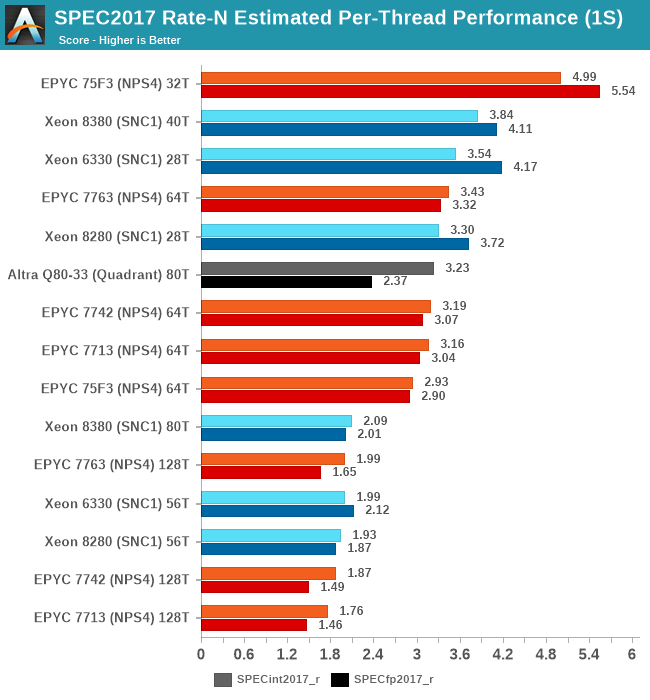Intel 3rd Gen Xeon Scalable (Ice Lake SP) Review: Generationally Big, Competitively Small
by Andrei Frumusanu on April 6, 2021 11:00 AM EST- Posted in
- Servers
- CPUs
- Intel
- Xeon
- Enterprise
- Xeon Scalable
- Ice Lake-SP
SPEC - Per-Core Performance under Load
A metric that is actually more interesting than isolated single-thread performance, is actually per-thread performance in a fully loaded system. This actually is a measurement and benchmark figure that would greatly interest enterprises and customers which are running software or workloads that are possibly licensed on a per-core basis, or simply workloads that require a certain level of per-thread service level agreement in terms of performance.
This has been a strong-point of Intel SKUs for some time now, even when the chips wouldn’t be competitive in terms of total throughput. With the new Ice Lake SPs SKUs now more notably increasing total throughput, it’ll be interesting to see the per-thread breakdown and resulting performance:

Because the total throughput generational performance increase is larger than the core count increase of the parts, this means that per-thread and per-core performance is higher with this generation. The Xeon 8380 is posting +16.3% and +10.4% per-thread performance versus the Xeon 8280 when only using one thread per core.
Interestingly, these figures are less at +8.2 and +7.4% when using both SMT threads per core. Intel has explained such an increase through the better usage of shared microarchitectural structure usage in the new Sunny Cove cores, essentially diminishing the SMT yield by improving 1/T per core performance.
Generally, Intel is extremely competitive in this benchmark metric, and while AMD easily beats them with the frequency-optimised parts, it’s an advantage that should help Intel in the SLA-centric workloads.










169 Comments
View All Comments
Oxford Guy - Tuesday, April 6, 2021 - link
Reading the conclusion I’m confused by how it’s possible for the product to be a success and for it to be both slower and more expensive.‘But Intel has 10nm in a place where it is economically viable’
Is that the full-fat 10nm or a simplified/weaker version? I can’t remember but vaguely recall something about Intel having had to back away from some of the tech improvements it had said would be in its 10nm.
Yojimbo - Tuesday, April 6, 2021 - link
Because there is more than the benchmarks that are in this review to making decisions when buying servers. Intel's entire ecosystem is an advantage much bigger than AMD's lead in benchmarks, as is Intel's ability to deliver high volume. The product will be a success because it will sell a lot of hardware. It will, however, allow a certain amount of market share to be lost to AMD, but less thanwpuld be lost without it. It will also cut into profit margins compared to if the Intel chips were even with the AMD ones in the benchmarks, or if Intel's 10 nm was as cost effective as they'd like it to be (but TSMC's 7 nm is not as cost effect as Intel would like they're processes to be, either).RanFodar - Tuesday, April 6, 2021 - link
This.Oxford Guy - Wednesday, April 7, 2021 - link
So, the argument here is that the article should have been all that instead of focusing on benchmarks.Yojimbo - Friday, April 9, 2021 - link
I never made any argument or made any suggestions for the article, I only tried to clear up your confusion: "Reading the conclusion I’m confused by how it’s possible for the product to be a success and for it to be both slower and more expensive." Perhaps the author should have been more explicit as to why he made his conclusion. To me, the publishing of server processor benchmarks on a hardware enthusiast site like this is mostly for entertainment purposes, although it might influence some retail investors. They are just trying to pit the processor itself against its competitors. "How does Intel's server chip stack up against AMD's server chip?" It's like watching the ball game at the bar.mode_13h - Saturday, April 10, 2021 - link
> To me, the publishing of server processor benchmarks on a hardware enthusiast site like this is mostly for entertainment purposes, although it might influence some retail investors.You might be surprised. I'm a software developer at a hardware company and we use benchmarks on sites like this to give us a sense of the hardware landscape. Of course, we do our own, internal testing, with our own software, before making any final decisions.
I'd guess that you'll find systems admins of SMEs that still use on-prem server hardware are probably also looking at reviews like these.
Oxford Guy - Sunday, April 11, 2021 - link
It's impossible to post a rebuttal (i.e. 'clear up your confusion') without making one or more arguments.I rebutted your rebuttal.
You argued against the benchmarks being seen as important. I pointed out that that means the article shouldn't have been pages of benchmarks. You had nothing.
trivik12 - Tuesday, April 6, 2021 - link
I wish there were test done with 2nd gen Optane memory. isn't that one of the selling point of Intel Xeon that is not there in Epyc or Arm Servers. Also please do benchmarks with P5800X optane SSD as that is supposedly fastest SSD around.Frank_M - Thursday, April 8, 2021 - link
Optane and Thunderbolt.Azix - Tuesday, April 6, 2021 - link
There's a reason intel's data center revenues are still massive compared to AMDs. These will sell in large quantities because AMD can't supply.